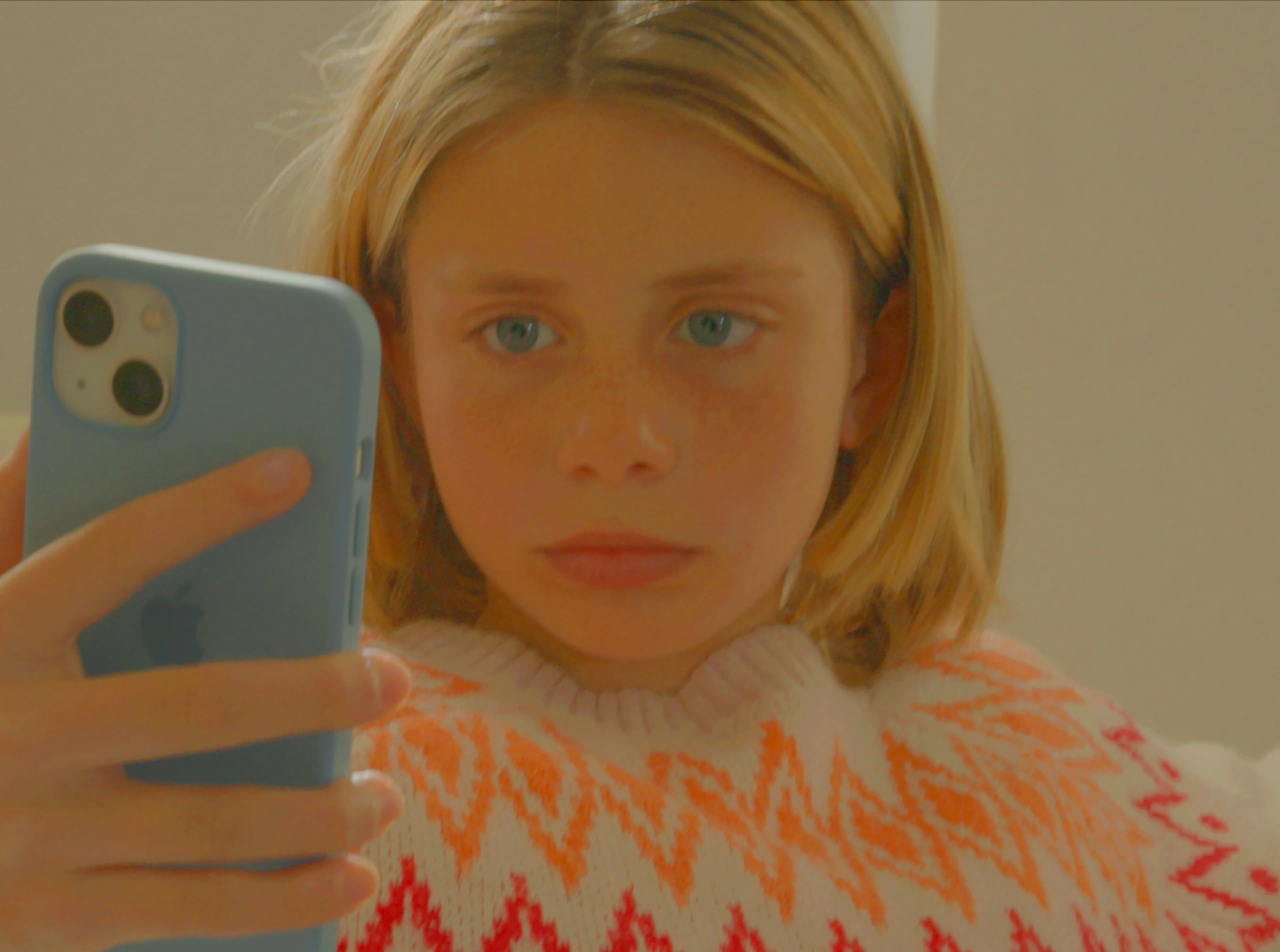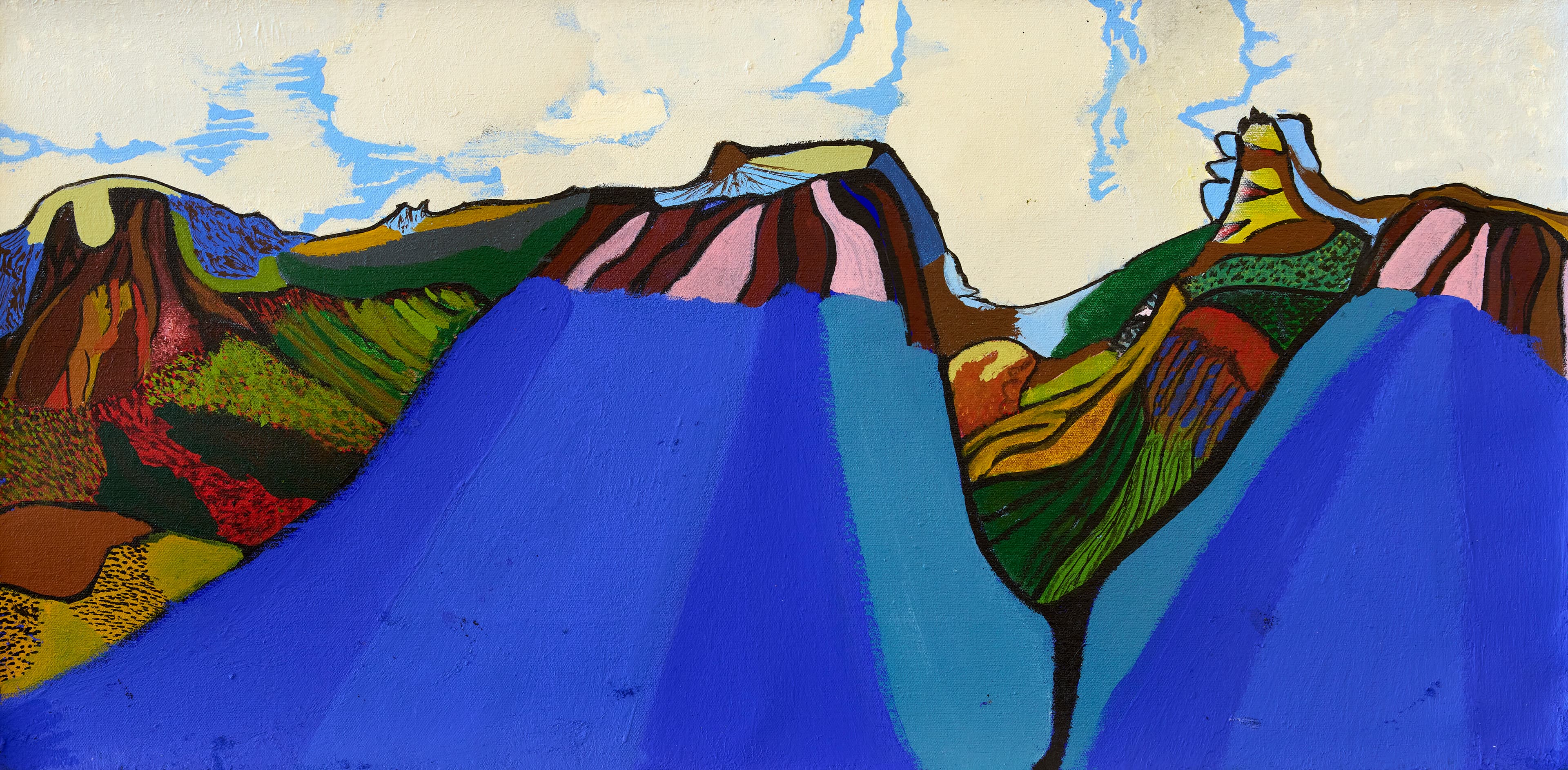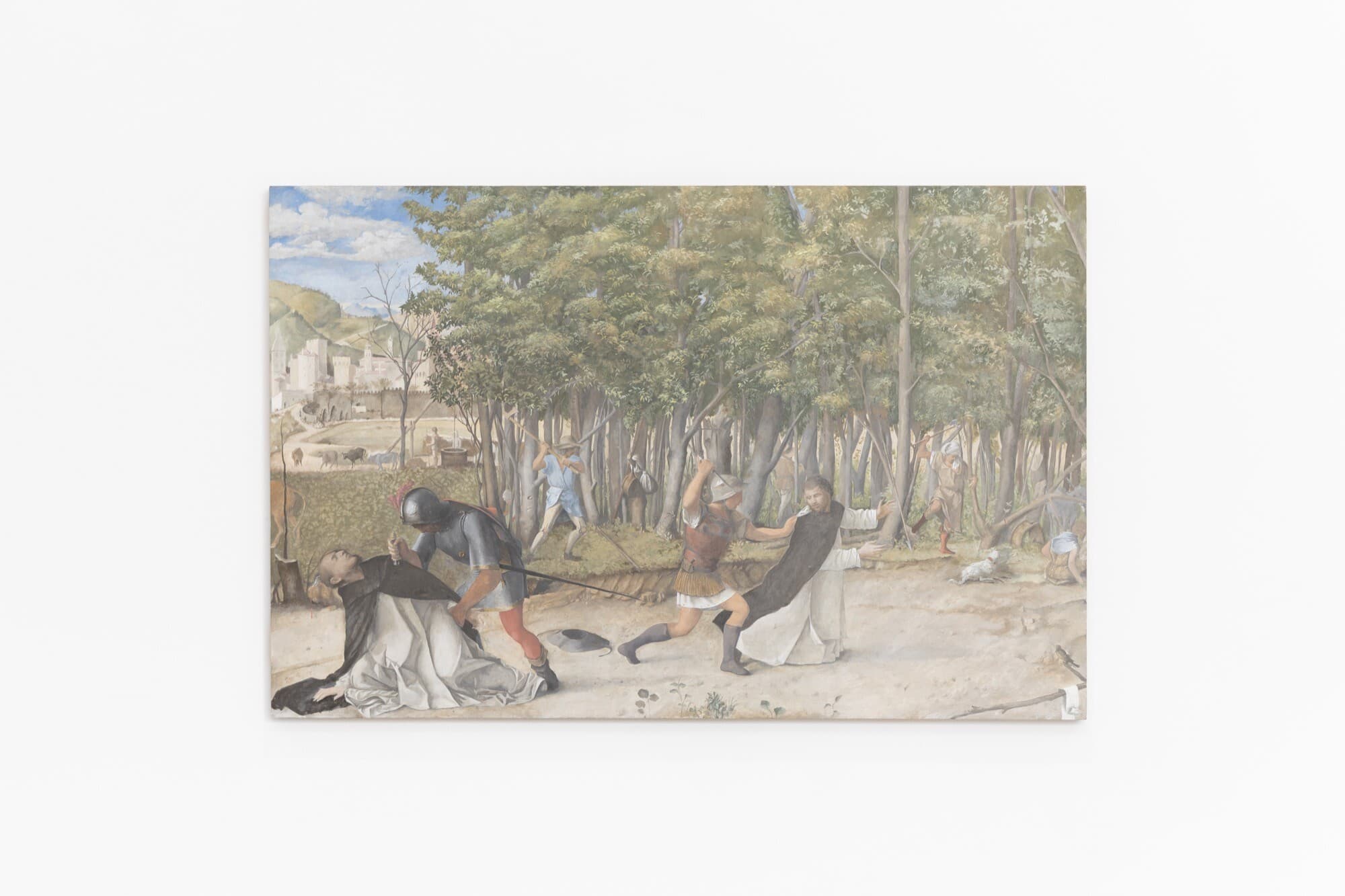Angela Goh, Body Loss (2017-), performed by Gemma Sattler. University of Melbourne Art Collection, 2024. Photo: Gregory Lorenzutti.
Angela Goh’s Body Loss; The same crowd never gathers twice
Philip Brophy
I didn’t see Angela Goh herself perform Body Loss—a solo performance work she created in 2017—at the start of the exhibition The Same Crowd Never Gathers Twice at Buxton Contemporary. I witnessed a proxy “do” the work toward the end of the exhibition run, enacted by Gemma Sattler (one half of the collaborative dancer duo gemma+molly). Its concept and its execution was thoroughly engaging and powerful, but for this review I would like to consider all that is muted or not enunciated by Body Loss and its inclusion in the Buxton exhibition.
Body Loss is refreshingly clear and succinct in its materialisation of bodily energy within a contoured space, in this case the architectonics of ye olde white cube. Gemma starts off sigh-moaning into a mic, digitally looping her voice in a succession of about four additional takes, after which the gallery space is filled with the vocal sonorum of female orality: upper register, breathy timbre, slight portamento slips, subtle quivering of tone. She then puts the mic down and proceeds to slowly crawl, slide, lunge, slip, and hang, using her body like a sensing organism coming into contact with floors, walls, corners, plinths, steps, and doorways. Throughout, her mouth forms an unmoving “O,” as if lip-synching the surrounding vo-chordal drone filling the gallery ambience. After conducting an improvisational surveillance of two gallery zones and the foyer, Gemma returns to her mic, piles what looks like a few too many cherries into her mouth, dribbles them a bit, and terminates the digital looping. The performance lasted for around twenty minutes.
The sight of Gemma evoked many things, the figure of the siren being the most obvious. Over twenty centuries since their early mention in Homer’s Odyssey (the circa eighth-century BC epic poem where they are not visually described), sirens have been imagined as chimera born of either avian or aquatic lineage. Variably, stringed lyres and lutes accompanied their siren songs. Ancient and classical bestiaries, manuscripts and statuettes have rendered these versions. Yet it remains remarkable that it is not until the eighteenth century that sirens and their ilk (mermaids, naiads, sprites, nymphs, sylphs, dryads, kelpies) become overtly—visually and physiologically—eroticised. The tell-tale sign of this shift is the female mouth agape: a salacious “O” that would progressively be compressed, posterised, logoised and objectified in the hands of numerous British, French, and German painters of renown. Yes, this is the lurid epoch of Romanticism and its fetishisation of Eros. For many, the political de-objectification of this disreputable period has been accomplished by the likes of low-threshold crit-comedy Hannah Gatsby’s It’s Pablo-matic “re-installation” of Picasso’s work at the Brooklyn Museum in 2018, and the #metoo gesticulation of Sonya Boyce’s “de-installation” of John William Waterhouse’s Hylas and the Nymphs (1896) at Manchester Art Gallery, also in 2018 (both interventions riding the foaming crest of Harvey Weinstein’s takedown undertow).
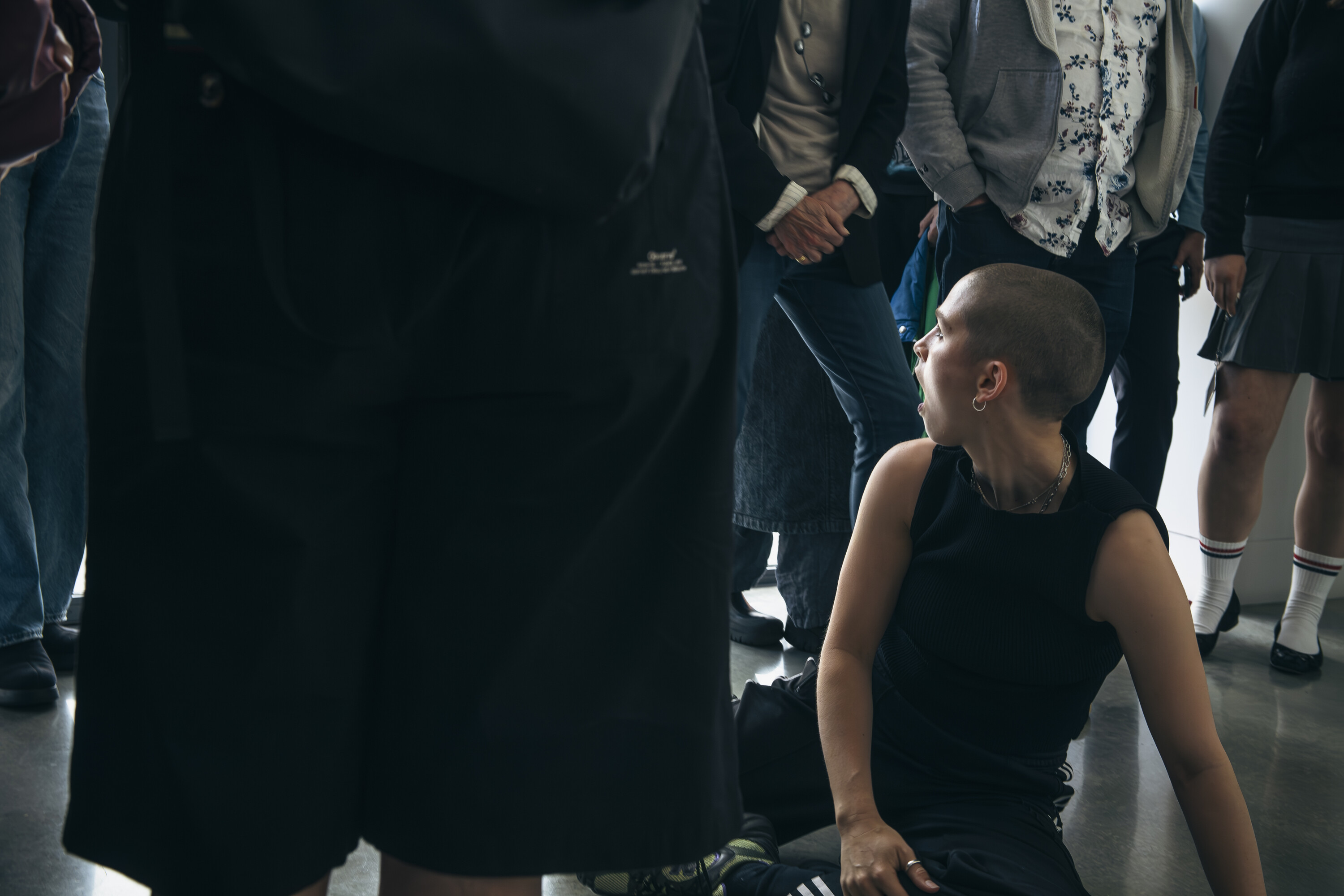
Angela Goh, Body Loss (2017-), performed by Gemma Sattler. University of Melbourne Art Collection, 2024. Photo: Gregory Lorenzutti.
Gemma’s “O” was a transfixing sight throughout her spatial dance. It worked to zero the performance onto a locked node within her corpus, marking her mouth—albeit physiologically silenced—as the energy source of her amoebic existence. It seemed as though she was sensing her surroundings through her mouth: seeing, hearing and assessing as she mapped space and charted trajectories of movement. In one way, she became an animated sex doll, meaning that her “O” mouth replicated the heat-sealed orifice of vinylised dolls designed for penile penetration (or, more unsettlingly, the sub-genre of gag porn). The disturbance excited by Gemma’s performance (via Goh’s instructions) is that she conjured an inanimate sexualised object come-to-life, moving like a domestic Roomba sucking in all life and space around her as she analytically proceeded through the reterritorialised dimensions of the gallery. In another way, her “O” ventriloquy evoked the silenced and unheard voices that ignited the “me too” utterance by Tarabe Burke for her Myspace page in 2006. In terms of symbolic intervention, the bodily simplicity of Body Loss is leaps ahead of the museographic takedowns of Gadsby and Boyce, even though all three might share base feminist sensibilities.
Gemma’s body at various moments became a figurative apparition of a wall hanging, a floor piece, and a plinth statuette. Neither a nude nor naked—a close-shaved head and lithe figure dressed in singlet top and tracksuit pants—Gemma activated something unexpected: she became the corporeal ghost of the “critically sodden” repository of Romanticist and Aestheticist dolls and playthings fantasised in the last poetical spluttering of fine art before it became revved up by Modernism. While I still find those contentious paintings to be morbidly fascinating and psycho-sexually engrossing, I can also see their painterly power as a precursor to the “precum power” wielded by the likes of Weinstein et al. The point is that Body Loss—due to it being in an art gallery, it must be noted—accrues all the sexualised negativity of Woman’s body placed on walls, floors, and plinths, and transforms that energy into a revitalised corporeality. Maybe I was alone in recalling the eroticised mouths and limbs that appear in William-Adolphe Bouguereau’s Les remords d’Oreste (1862), Anton Frederick Sandys’s Morgan Le Fay (1864), Gustave Doré’s The Enigma (1871), Luis Ricardo Faléro’s Vision of Faust (1878), Arnold Böcklin’s Ocean Breakers (The Sound) (1886), John William Waterhouse’s The Lady of Shalott (1888), Franz Stuck’s The Sphinx (1895), Jean Leon Gerôme’s Truth Arising From Her Well (1896), Herbert James Draper’s The Water Nymph (c.1900), and Carlos Schwabe’s The Wave (1907). Watching Gemma’s shape-shifting moves reminded me of standing in front of such works in grand museums across Europe. The eventfulness of Body Loss allowed this contemplation.
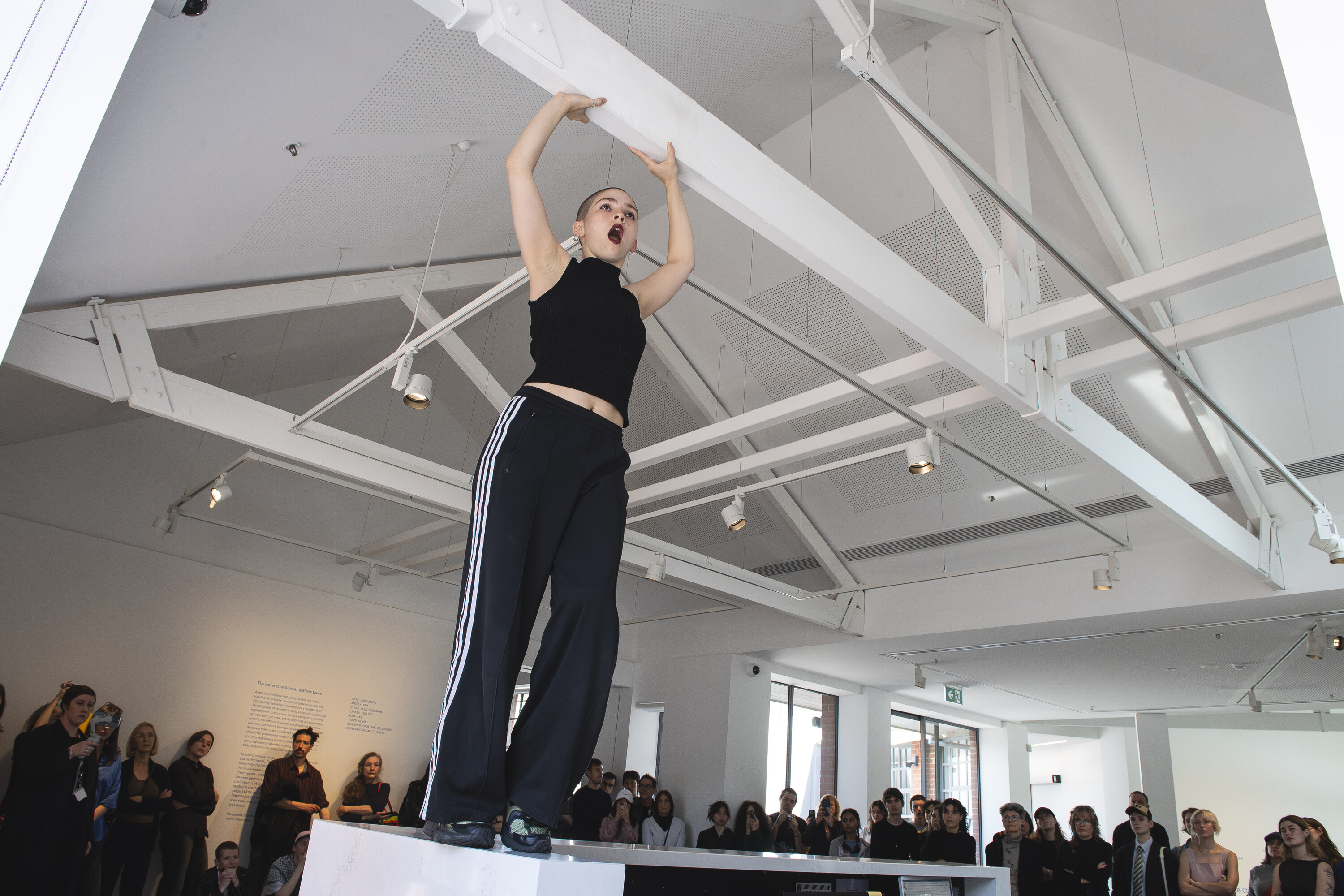
Angela Goh, Body Loss (2017-), performed by Gemma Sattler. University of Melbourne Art Collection, 2024. Photo: Gregory Lorenzutti.
Viewed in this somewhat darker light, Body Loss acts out a para-Gothic trope of violence and vengeance, retribution and restitution. Though not an essential component of Goh’s directives, Gemma’s tightly clippered head triggered this, morphologically linking Renée Jeanne Falconetti’s close-ups in Carl Dreyer’s silent movie The Passion of Joan of Arc (1928) to Robert Capa’s photo The Shaved Woman of Chartres (1944), capturing a town’s glee in humiliating a “horizontal collaborator” during WWII, to Sigourney Weaver’s alien-impregnated heroine with shaved head in David Fincher’s Alien ^3^ (1992), to a shaven-headed Sinead O’Connor ripping up a picture of the Pope to a silenced audience on Saturday Night Live in 1992, to Jennifer Jason Leigh’s sudden buzz-cut appearance at the nihilistic closure of Ulu Grosbard’s Georgia (1995), to Demi Moore’s macho clipper cut for G.I. Jane (1997). Embedded within Gemma’s Butoh busker with a Boss loop station, this familial lineage of persecuted women performing a series of self-immolating statements is subliminally audited throughout this iteration of Body Loss.
But something is missing in this discussion of Body Loss: the audience. The Saturday afternoon performance I attended had around sixty people, clustered along the walls, on the floor and in the entrance to the main ground floor gallery. In fact, these were the very sites and zones Gemma would “reclaim” during her mobilisation. Her activation of the space required a redistribution of the audience, all of whom were passive-aggressively forced into vacating their positions. It soon became apparent to everyone there that any spot they temporarily occupied would likely be taken over by Gemma’s slowly squirming body. This being a public space of sorts (Buxton Contemporary labels itself a “public art museum”), people seemed to resort to a behavioural mode familiar in real-world public space. I’m talking of the nervy energy that controls a public channel when the “aberrant” body of the disabled, the demented, the senile, the unmedicated, or the plainly drug-fucked carves their way through a crowd. Everyone knows that all but one of them is conscious of the single being whose actions are self-othering amidst their conjoined rational consciousness. No-where is this more obvious than on Melbourne’s public transport network and its hydra-headless operation of timetabled drivers who never notice or observe any such activity happening in the user areas beyond their scopic control. As a cooing Gemma psychically prods the audience’s body like socialised taffy, I’m reminded of a diametrically opposed performance: Tony Schwensen’s remarkable short performance from the mid 2000s where, dressed in track suit pants and an Australian flag draped over his shoulders, he brandishes a blaring blower vac to literally and physically blow an audience of twenty or so patrons out of a small gallery place.
Contemporary art patrons are well-versed in the protocols of such social interactions and blockages. Since Fluxus systematically “intervened” with the gallery’s dominion, le cube blanc has for decades been a place where viewers accord the self-spotlighting theatrics of a performance artist a reverence rarely granted operatives in the most official realms. Gallery aficionados persistently link this to “expanded theatre,” or body Actionism and its performative confrontation. I mostly find gallery-situated Performance Art mannered, narcissistic, vainglorious, and unfulfilling of its implied dynamisation of theatre experientialism. Body Loss is the sole live performance work contained within The Same Crowd Never Gathers Twice. Most of the works in the exhibition are complex, and present intriguing discursive angles on performativity. (In particular, Riana Head-Toussaint’s Animate Loading: 1, 2022, and Fraught Outfit’s Flames Danced In Their Hair But Did Not Burn Them, 2024, warrant critical discussion outside the scope of this review.) Yet the exhibition’s curatorial intent to “test the limits of the (public) arena” couches some lofty pretensions in its assumptions of communality in public spaces. Put bluntly, the gallery seems to be the last place where one could either present researched investigations into group dynamics and behavioural confluences, or stage activated outcomes and experimental interactions under the rubric of eventfulness. What could be more self-cancelling than the gallery’s over-compensating propriety of acceptance and inclusion? What could be more unreal than role-playing and workshopping charades of difference between spectator and participants in such a safely demarcated enclosure? These were the thoughts taunting me as I sashayed here and there in a game of slo-mo parkour-tag at Buxton Contemporary.
Gemma’s performance was enthusiastically received upon her concluding gesture. Then again, I think it’s been decades since I’ve attended a performance art or choreographed event within a gallery that hasn’t concluded with a cathartic output of communal celebration. Maybe this is the drive behind The Same Crowd Never Gathers Twice. It theoretically invokes the collaborative public space experiments in environment performance by Anna and Lawrence Halprin in the latter 1960s in California. It also rides the trend of dancers taking-over architecturally vaunted spaces—such as the Jonah Bokaer’s The Metamorphoses performed in 2017 throughout the spaces and grounds of Philip Johnson’s Glass House in Connecticut (not to mention Anne Imhof’s Faust for the Venice Biennale’s German Pavilion that same year). Watching Gemma slide backwards in a crawl stance along the polished concrete floor at Buxton Contemporary, I had no such thoughts of intervention, activation or public engagement. Instead, Michael Jackson’s first “moonwalk” during Billy Jean live on the TV show Motown 25: Yesterday, Today, Forever in 1983 jumped into my mind. Within seconds, I saw Gemma’s horizontal glide as a bodily contrail from a lineage of gravitational embrace—that is, the opposite of Dance’s vaunted liberation of flight. The momentum of Body Loss might seem to be the opposite of the violent krumping of South Central LA (documented in Dave LaChapelle’s documentary Rize in 2005), but its difference could be one of cosmological temporality. Public transport divides people through aberration; public museums aim to combine people through activation. Accordingly, the track-suited “body jolting” of Miss Prissy street krumping to fractured beats is here transformed into the track-suited “body blobbing” of a lone dancer spilling her siren self like viscous gloop. A pre-title statement opens Rize: “The footage in this film has not been sped up in any way.” Body Loss intones the same.
Philip Brophy writes on art among other things.
